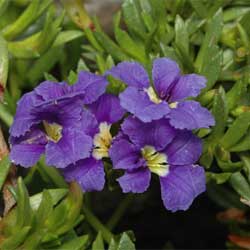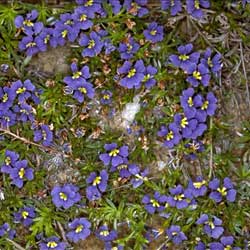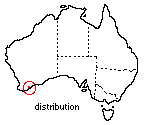Dampiera diversifolia
 |
 |
Dampiera diversifolia de Vriese
Dampiera diversifolia occurs in the southwest of Western Australia where, with other members of the family Goodeniaceae, it forms an important part of the spring wildflower display.
 It
is a prostrate perennial, or undershrub, varying from 25 cm to 1 m in diameter.
The short, dense, leafy branches produce a compact ground cover which is surmounted
in the spring and summer by a crown of small purple-blue flowers. This depth
of colour is rarely surpassed by any other blue flowering species of plant.
It
is a prostrate perennial, or undershrub, varying from 25 cm to 1 m in diameter.
The short, dense, leafy branches produce a compact ground cover which is surmounted
in the spring and summer by a crown of small purple-blue flowers. This depth
of colour is rarely surpassed by any other blue flowering species of plant.
The flower differs from all other Dampiera and is held on short axillary peduncles or branchlets, with one or two leaves and a pair of bracteoles per flower. The radical leaves vary from oblong-spathulate to oblanceolate rarely above 2.5 cm in length. The other leaves vary from lanceolate to linear but are rarely longer than 1 cm. The appearance of the second set of leaves often resembles that of an epacrid (a member of the family Ericaceae).
Propagation is normally from cuttings, producing excellent results in the late spring, summer and early autumn.
This species of Dampiera is quite hardy in the Canberra district, resisting frosts successfully for a number of years. Although it survives in a wide range of conditions it does prefer a well-drained site with some protection from winds and the invasion of more vigorous species.
When grown from cuttings it may need time to establish itself successfully, normally about twelve months. Then it usually spreads quite rapidly until reaching its maximum size.
Dampiera diversifolia suckers readily in good friable soil and this aids its hardiness.
A general fertilizer in spring and autumn prevents any tendency for it to die back in the centre.
Text by: ANBG staff, 1977
* RHS colour chart, 1966: corolla, violet-blue group 95A.
Name meaning: Dampiera diversifoliaDampiera after William Dampier (1652-1715), a buccaneer who collected some Australian plants which are still preserved in the British Museum at Oxford; diversifolia with leaves of more than one kind. |
![An Australian Government Initiative [logo]](/images/austgovt_brown_90px.gif)

